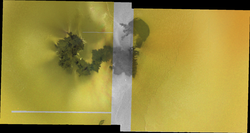Prometheus (volcano)

Galileo color mosaic of the volcano Prometheus and its eruption plumes. Prometheus Patera is the kidney-shaped dark region at upper right; the magma source vent is situated in the narrow "neck" directly below it. From the latter, the western flow field stretches to the left, with most of the SO2 plumes being erupted from the flow margins at the left end.[1]
Prometheus is an active volcano on Jupiter's moon Io. It is located on Io's hemisphere facing away from Jupiter at 1°31′S 153°56′W / 1.52°S 153.94°W / -1.52; -153.94Coordinates: 1°31′S 153°56′W / 1.52°S 153.94°W / -1.52; -153.94.[2]
Description
Prometheus consists of a 28-kilometer (17 mi)-wide volcanic pit named Prometheus Patera and a 100-kilometer (62 mi)-long compound lava flow, all surrounded by reddish sulfur and circular, bright sulfur dioxide volcanic plume deposits.[3] The volcano was first observed in images acquired by the Voyager 1 spacecraft in March 1979.[4] Later that year, the International Astronomical Union named this feature after a Greek fire god, Prometheus.
Prometheus is the site of a volcanic eruption that has been ongoing since at least the Voyager 1 encounter in 1979. Between the Voyager encounters and the first observations by Galileo, a 6,700-square-kilometer (2,600 sq mi) flow field was emplaced.[5] Later Galileo observations of this flow field revealed numerous small breakouts, particularly on the western end of the flow field.[6]
Prometheus is the site of two volcanic eruption plumes: a small, sulfur-rich plume erupting from the magma-source vent at the eastern end of the flow field and a 75-to-100-kilometer (47 to 62 mi)-tall, SO
2-rich dust plume erupting from the active flow front at the other end.[3] The former forms a diffuse, red deposit to the east of the Prometheus flow field. The latter forms a bright, circular deposit surrounding the entire volcano and lava flow. The SO
2-rich plume is generated as lava at the western end of the flow field covers sulfur dioxide frost, heating and vaporizing it.[7] This is accomplished at multiple breakouts, generating gas and dust for the visible dust plume.[8] Prometheus' plume has been observed by both Voyager spacecraft, Galileo, and New Horizons, at every appropriate imaging opportunity.
| Wikimedia Commons has media related to Prometheus (volcano). |
References
^ Leone, G.; Gerard Davies, A.; Wilson, L.; Williams, D. A.; Keszthelyi, L. P.; Jaeger, W. L.; Turtle, E. P. (2009). "Volcanic history, geologic analysis and map of the Prometheus Patera region on Io". Journal of Volcanology and Geothermal Research. 187: 93. Bibcode:2009JVGR..187...93L. doi:10.1016/j.jvolgeores.2009.07.019..mw-parser-output cite.citation{font-style:inherit}.mw-parser-output q{quotes:"""""""'""'"}.mw-parser-output code.cs1-code{color:inherit;background:inherit;border:inherit;padding:inherit}.mw-parser-output .cs1-lock-free a{background:url("//upload.wikimedia.org/wikipedia/commons/thumb/6/65/Lock-green.svg/9px-Lock-green.svg.png")no-repeat;background-position:right .1em center}.mw-parser-output .cs1-lock-limited a,.mw-parser-output .cs1-lock-registration a{background:url("//upload.wikimedia.org/wikipedia/commons/thumb/d/d6/Lock-gray-alt-2.svg/9px-Lock-gray-alt-2.svg.png")no-repeat;background-position:right .1em center}.mw-parser-output .cs1-lock-subscription a{background:url("//upload.wikimedia.org/wikipedia/commons/thumb/a/aa/Lock-red-alt-2.svg/9px-Lock-red-alt-2.svg.png")no-repeat;background-position:right .1em center}.mw-parser-output .cs1-subscription,.mw-parser-output .cs1-registration{color:#555}.mw-parser-output .cs1-subscription span,.mw-parser-output .cs1-registration span{border-bottom:1px dotted;cursor:help}.mw-parser-output .cs1-hidden-error{display:none;font-size:100%}.mw-parser-output .cs1-visible-error{font-size:100%}.mw-parser-output .cs1-subscription,.mw-parser-output .cs1-registration,.mw-parser-output .cs1-format{font-size:95%}.mw-parser-output .cs1-kern-left,.mw-parser-output .cs1-kern-wl-left{padding-left:0.2em}.mw-parser-output .cs1-kern-right,.mw-parser-output .cs1-kern-wl-right{padding-right:0.2em}
^ Blue, Jennifer (October 1, 2008). "Io Nomenclature: Eruptive center". USGS. Retrieved 2008-10-01.
^ ab Davies, A. (2007). "Prometheus and Amirani: effusive activity and insulated flows". Volcanism on Io: A Comparison with Earth. Cambridge University Press. pp. 208&ndash, 216. ISBN 0-521-85003-7.
^ Smith, B. A.; et al. (1979). "The Jupiter system through the eyes of Voyager 1". Science. 204 (4396): 951&ndash, 972. Bibcode:1979Sci...204..951S. doi:10.1126/science.204.4396.951. PMID 17800430.
^ McEwen, A. S.; et al. (1998). "Active Volcanism on Io as Seen by Galileo SSI". Icarus. 135: 181&ndash, 219. Bibcode:1998Icar..135..181M. doi:10.1006/icar.1998.5972.
^ Keszthelyi, L.; et al. (2001). "Imaging of volcanic activity on Jupiter's moon Io by Galileo during the Galileo Europa Mission and the Galileo Millennium Mission". J. Geophys. Res. 106: 33025&ndash, 33052. Bibcode:2001JGR...10633025K. doi:10.1029/2000JE001383.
^ Kieffer, S.W.; et al. (2000). "Prometheus: Io's Wandering Plume". Science. 288 (5469): 1204&ndash, 1208. Bibcode:2000Sci...288.1204K. doi:10.1126/science.288.5469.1204.
^ Milazzo, M. P.; et al. (2001). "Observations and initial modeling of lava-SO
2 interactions at Prometheus, Io". J. Geophys. Res. 106: 33121&ndash, 33128. Bibcode:2001JGR...10633121M. doi:10.1029/2000JE001410.

